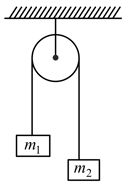Newton's Law of Motion
Newton's Law of Motion: Overview
This topic covers concepts, such as Force, Newton's Laws of Motion, Motion of Connected Bodies & Motion on Inclined Plane etc.
Important Questions on Newton's Law of Motion
Physical independence of force is a consequence of,
A lift weighing is moving upwards with an acceleration of . The tension in the supporting cable is
If a cricketer catches a ball of mass moving with a velocity of , then he experiences a force of (Time taken to complete the catch is )
A block has been placed on an inclined plane with the slope angle block slides down the plane at constant speed. The coefficient of kinetic friction is equal to :
Three identical blocks of masses are drawn by a force on a frictionless surface, then what is the tension (in ) in the string between the blocks and ?

A player caught a cricket ball of mass moving at a rate of . If, the catching process is completed in , the force of the blow exerted by the ball on the hand of the player is equal to
A particle of mass is subjected to a force with . What will be its initial acceleration if it is released from a point away from the origin?
Two masses and tied to a string are hanging over a light frictionless pulley. What is the acceleration of the masses when left free to move? ( )

Two masses and tied to a string are hanging over a light frictionless pulley. What is the acceleration of the masses when left free to move? ( )

A spring balance is attached to the ceiling of a lift. A man hangs his bag on the spring and the spring reads when the lift is stationary. If the lift moves downward with an acceleration of , the reading of the spring balance will be,
A light spring balance hangs from the hook of the other light spring balance and a block of mass hangs from the former one. Then the true statement about the scale reading is –
If suddenly the gravitational force of attraction between earth and a satellite revolving around it becomes zero, then the satellite will –
Under special circumstances, a body's
A body of mass has an initial velocity of along -axis and it is subjected to a force of in -direction. The distance of the body from origin after seconds will be: (the body was subjected to force at the origin at )
An air-tight cage with a parrot sitting in it is suspended from the spring balance. The parrot starts flying. The reading of the spring balance will
Three blocks and having masses and are attached by massless strings and ideal pulleys as shown in the figure. When the system is released from rest if the block ' ' remains stationary, the mass of block ' ' is

A body of mass hangs at one end of a string of length , the other end of which is fixed. It is given a horizontal velocity so that the string would just reach where it makes an angle of with the vertical. The tension in the string at mean position is
The rough surface of a horizontal table offers a definite maximum opposing force to initiate the motion of a block along the table, which is proportional to the resultant normal force given by the table. Forces and act at the same angle with the horizontal and both are just initiating the sliding motion of the block along the table. Force is a pulling force while the force is a pushing force. , because
Consider following forces: Force due to tension along a string, Normal force given by a surface, Force due to air resistance and Buoyant force or upthrust given by a fluid. Which of these are electromagnetic forces?
A string passes over a smooth pulley with masses and attached to the ends of the string and hanging vertically. The tension in the string is
